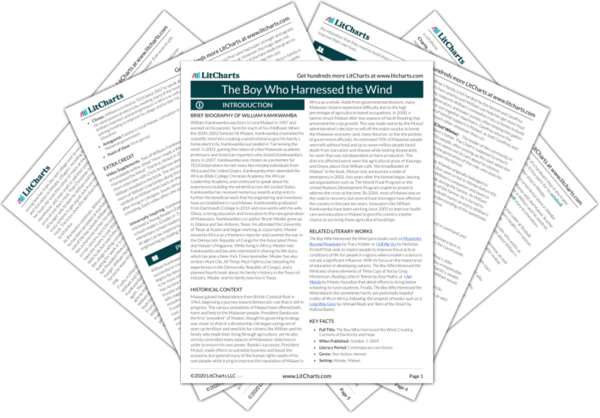Brief Biography of William Kamkwamba
William Kamkwamba was born in rural Malawi in 1987 and worked on his parents’ farm for much of his childhood. When the 2000-2002 famines hit Malawi, Kamkwamba channeled his scientific mind into creating a wind turbine to give his family’s home electricity. Kamkwamba succeeded in “harnessing the wind” in 2002, gaining the notice of a few Malawian academic professors and American reporters who shared Kamkwamba’s story. In 2007, Kamkwamba was chosen as a presenter for TEDGlobal where he met many like-minded individuals from Africa and the United States. Kamkwamba then attended the African Bible College Christian Academy, the African Leadership Academy, and continued to speak about his experiences building the windmill across the United States. Kamkwamba has received numerous awards and grants to further the beneficial work that his engineering and inventions have accomplished in rural Malawi. Kamkwamba graduated from Dartmouth College in 2014 and now works with his wife, Olivia, to bring education and innovation to the new generation of Malawians. Kamkwamba’s co-author Bryan Mealer grew up in Odessa and San Antonio, Texas. He attended the University of Texas at Austin and began working as a journalist. Mealer moved to Africa as a freelance reporter and covered the war in the Democratic Republic of Congo for the Associated Press and Harper’s Magazine. While living in Africa, Mealer met Kamkwamba and became interested in sharing his life story, which became a New York Times bestseller. Mealer has also written Muck City, All Things Must Fight to Live (detailing his experiences in the Democratic Republic of Congo), and a planned fourth book about his family’s history in the Texas oil industry. Mealer and his family now live in Texas.
Historical Context of The Boy Who Harnessed the Wind
Malawi gained independence from British Colonial Rule in 1964, beginning a journey toward democratic rule that is still in progress. The various presidents of Malawi have offered both harm and help to the Malawian people. President Banda was the first “president” of Malawi, though his governing strategy was closer to that of a dictatorship. He began a program of start-up fertilizer and seed kits for citizens like William and his family who made their living through agriculture, yet he also strictly controlled many aspects of Malawians’ daily lives in order to ensure his own power. Banda’s successor, President Muluzi, made efforts to subsidize business and boost the economy, but ignored many of the human rights needs of his own people while trying to improve the reputation of Malawi in Africa as a whole. Aside from governmental divisions, many Malawian citizens experience difficulty due to the high percentage of agricultural-based occupations. In 2000, a famine struck Malawi after two seasons of harsh flooding that prevented the crop growth. This was made worse by the Muluzi administration’s decision to sell off the maize surplus to boost the Malawian economy (and, many theorize, to line the pockets of government officials). An estimated 70% of Malawian people were left without food and up to seven million people faced death from starvation and disease while looking desperately for work that was not dependent on farm production. The districts affected worst were the agricultural areas of Kasungu and Dowa, places that William calls “the breadbasket of Malawi” in the book. Muluzi only announced a state of emergency in 2002, two years after the famine began, leaving aid organizations such as The World Food Program or the United Nations Development Program unable to properly address the crisis at the time. By 2004, most of Malawi was on the road to recovery, but several food shortages have affected the country in the past ten years. Innovators like William Kamkwamba have been working since 2005 to improve health care and education in Malawi to give this country a better chance at surviving these agricultural hardships.
Other Books Related to The Boy Who Harnessed the Wind
The Boy Who Harnessed the Wind joins books such as
Mountains Beyond Mountains by Tracy Kidder or
Half the Sky by Nicholas Kristoff that seek to inspire people to improve the practical conditions of life for people in regions where modern science is not yet a significant influence. With its focus on the importance of education in developing nations,
The Boy Who Harnessed the Wind also shares elements of
Three Cups of Tea by Greg Mortenson,
Reading Lolita in Tehran by Azar Nafisi, or
I Am Malala by Malala Yousafzai that detail efforts to bring better schooling to rural countries. Finally,
The Boy Who Harnessed the Wind depicts the sometimes harsh, yet potentially hopeful reality of life in Africa, following the projects of books such as
A Long Way Gone by Ishmael Beah and
Tears of the Desert by Halima Bashir.
Key Facts about The Boy Who Harnessed the Wind
-
Full Title: The Boy Who Harnessed the Wind: Creating Currents of Electricity and Hope
-
When Published: October 1, 2009
-
Literary Period: Contemporary non-fiction
-
Genre: Non-fiction, memoir
-
Setting: Wimbe, Malawi
-
Climax: William is invited to TEDGlobal 2007 to speak about his wind-powered electricity, meeting many of the most brilliant inventors and entrepreneurs in Africa as well as gaining funding to improve his village and further his education.
-
Antagonist: Famine in rural Malawi, corruption in the Malawian government
-
Point of View: First person
Extra Credit for The Boy Who Harnessed the Wind













